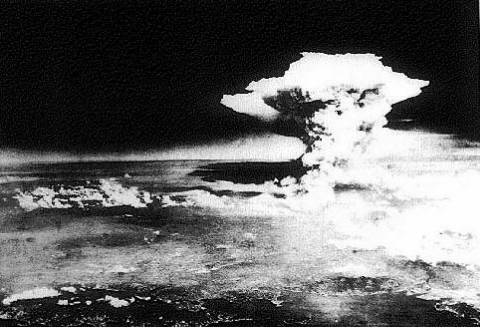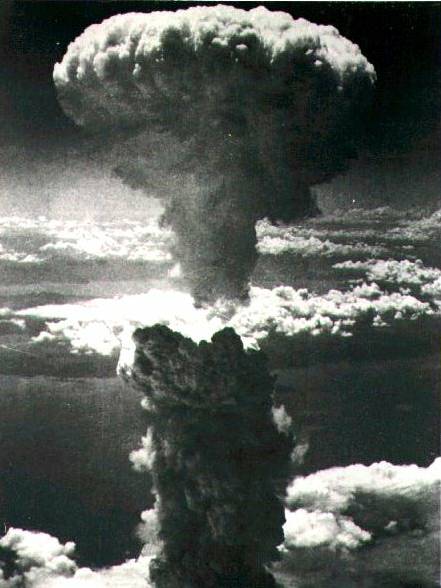

Operation Teapot 1955.
Operation Teapot was a series of fourteen nuclear test explosions conducted at the Nevada Test Site in the first half of 1955.
During shot "Wasp", ground forces took part in Exercise Desert Rock VI which included an armored task force "Razor" moving to within 900 meters of ground zero, under the still-forming mushroom cloud.
The Civil Defense "Apple-2" shot on May 5, 1955 was intended to test various building construction types in a nuclear blast. A few of the buildings still stand at Area 1, NTS. A documentary film was produced showing the buildings being damaged by the blast; in the film, the test is called "Operation Cue". Total Runtime Appx. 30 minutes.
Operation Cue 1955.
Eerie nuclear tests on houses and dummies at the Nevada Test Site. Total Runtime Appx. 14 minutes.
Operation REDWING 1956.
Operation Redwing was a United States series of 17 nuclear test detonations from May to July 1956. They were conducted at Bikini and Eniwetok atolls. The entire operation followed Operation Wigwam and preceded Operation Plumbbob. The primary intention was to test new, second-generation thermonuclear devices. Fission devices intended to be used as primaries for thermonuclear weapons, and small tactical weapons for air defense were also tested. Redwing is notable for having demonstrated the first airdrop of a deliverable hydrogen bomb - test "Cherokee". Because the yields for many tests at Operation Castle in 1954 were dramatically higher than predictions, Redwing was conducted using an "energy budget" - there were limits to the total amount of energy released, and the amount of fission yield was also strictly controlled. Fission, primarily "fast" fission of the natural uranium tamper surrounding the fusion capsule, greatly increases the yield of thermonuclear devices, and contributes the vast majority of the fallout - fusion being a relatively clean reaction. Total Runtime Appx. 31 minutes.
Operation Argus 1958.
Operation Argus was a series of nuclear weapons tests and missile tests secretly conducted during August and September of 1958 over the South Atlantic Ocean by the United States's Defense Nuclear Agency, in conjunction with the Explorer 4 space mission. Operation Argus was conducted between the nuclear test series Operation Hardtack I and Operation Hardtack II. Contractors from Lockheed Aircraft Corporation as well as a few personnel and contractors from the U.S. Atomic Energy Commission were on hand as well. The time frame for Argus was substantially expedited due to the instability of the political environment [bans on atmospheric and exoatmospheric testing were forthcoming]. Consequently, the tests were conducted within a mere half year of conception (whereas "normal" testing took one to two years). Total Runtime Appx. 45 minutes.
Operation HARDTACK Basic Effects Tests 1958.
Operation Hardtack I & II was a series of 72 nuclear tests conducted by the United States in 1958. With test moratoriums on the horizon, American weapons labs rushed out many new designs. Hardtack I was carried out in the Pacific Ocean, at Bikini Atoll, Enewetak Atoll, and Johnston Island.
Hardtack II was carried out later that year at the Nevada Test Site, while the US simultaneously carried out the secret Operation Argus over the south Atlantic Ocean in September. Hardtack II consisted exclusively of low-yield atmospheric and underground tests, and 17 one-point safety tests. Total Runtime Appx. 26 minutes.
Operation HARDTACK High Altitude Tests 1958.
Operation Hardtack I & II was a series of 72 nuclear tests conducted by the United States in 1958. With test moratoriums on the horizon, American weapons labs rushed out many new designs. Hardtack I was carried out in the Pacific Ocean, at Bikini Atoll, Enewetak Atoll, and Johnston Island.
Hardtack II was carried out later that year at the Nevada Test Site, while the US simultaneously carried out the secret Operation Argus over the south Atlantic Ocean in September. Hardtack II consisted exclusively of low-yield atmospheric and underground tests, and 17 one-point safety tests. Total Runtime Appx. 25 minutes.
Operation HARDTACK Underwater Tests 1958.
Operation Hardtack I & II was a series of 72 nuclear tests conducted by the United States in 1958. With test moratoriums on the horizon, American weapons labs rushed out many new designs. Hardtack I was carried out in the Pacific Ocean, at Bikini Atoll, Enewetak Atoll, and Johnston Island.
Hardtack II was carried out later that year at the Nevada Test Site, while the US simultaneously carried out the secret Operation Argus over the south Atlantic Ocean in September. Hardtack II consisted exclusively of low-yield atmospheric and underground tests, and 17 one-point safety tests. Total Runtime Appx. 19 minutes.
Project Dugout 1960.
Lawrence Radiation Laboratory Technical Film Report, part-animated, showing underground nuclear detonation tests. Total Runtime Appx. 8 minutes.
Operation DOMINIC Nuclear Tests 1962.
Operation Dominic was a series of 105 nuclear test explosions conducted in 1962 and 1963 by the United States. Those conducted in the Pacific are sometimes called Dominic I. The blasts in Nevada are known as Dominic II. This test series was scheduled quickly, in order to take advantage of the Soviet abandonment of the 1958-61 test moratorium. Most of these shots were conducted with free-fall bombs dropped from B-52 bomber aircraft. Twenty of these shots were to test new weapons designs; six to test weapons effects; and several shots to confirm the reliability of existing weapons. The Thor missile was also used to loft warheads into near-space to conduct high altitude nuclear explosion tests; these shots were collectively called Operation Fishbowl.
Operation Dominic I, shot Arkansas
Operation Dominic occurred during a period of high Cold War tension between the United States and the Soviet Union, since the Cuban Bay of Pigs Invasion had occurred not long before. Nikita Khrushchev announced the end of a three-year moratorium on nuclear testing on August 30, 1961, and Soviet tests recommenced on 1 September, initiating a series of tests that included the detonation of the Tsar Bomba. President John F. Kennedy responded by authorizing Operation Dominic. It was the largest nuclear weapons testing program ever conducted by the United States, and the last atmospheric test series conducted by the U.S., as the Limited Test Ban Treaty was signed in Moscow the following year. Total Runtime Appx. 26 minutes.

